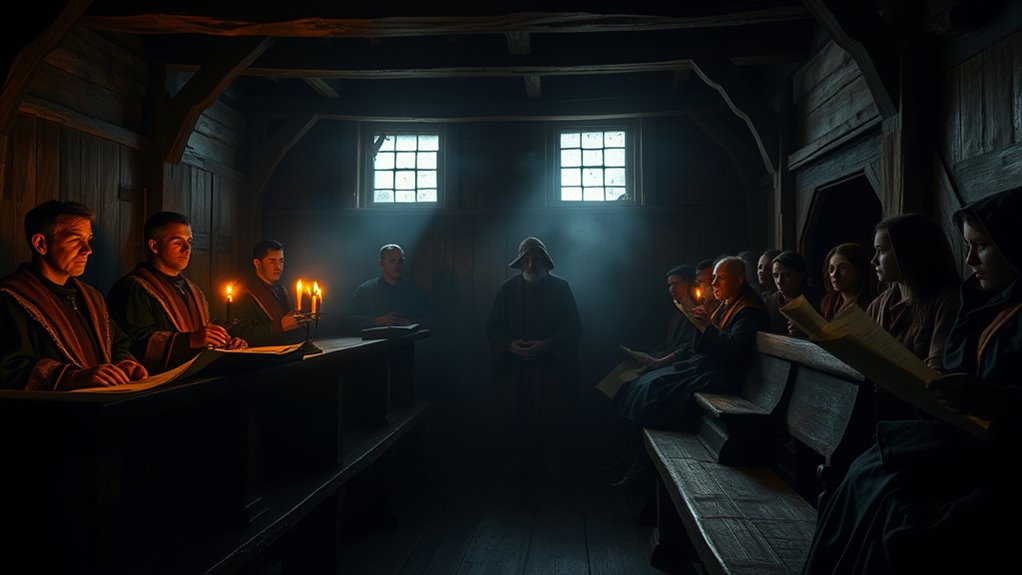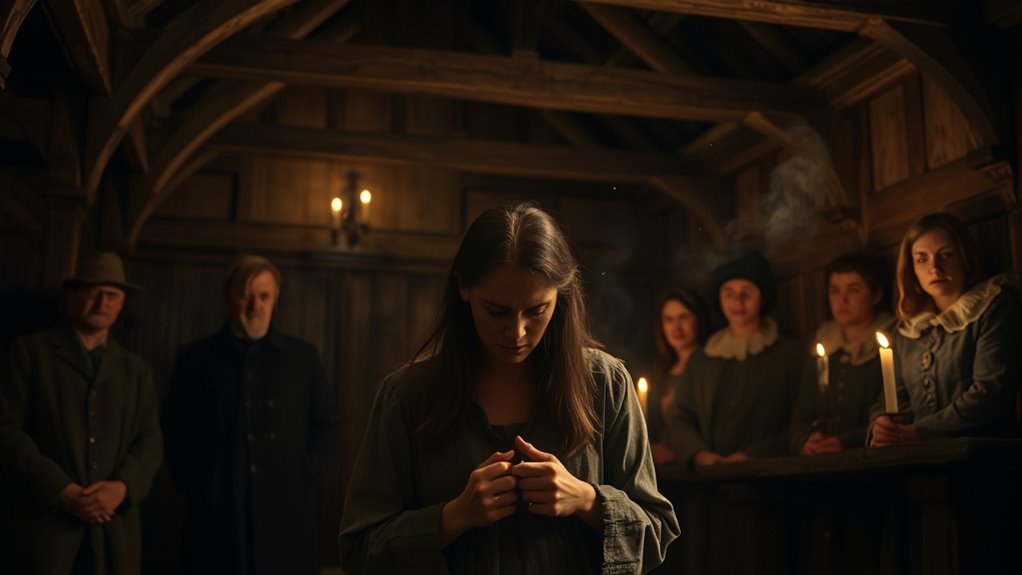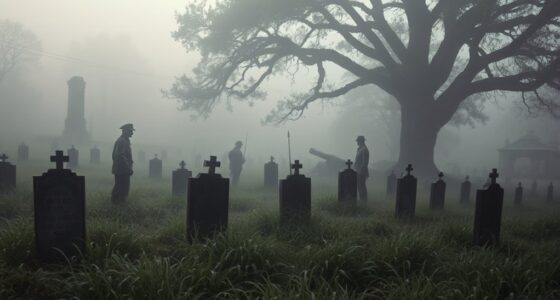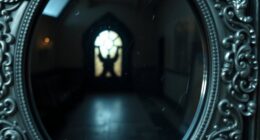The Salem Witch Trials of 1692 happened in colonial Massachusetts, fueled by religious hysteria and fear of evil spirits. Spectral evidence, or accusations based on spirits and visions, played a big role in convicting many innocent people. The community’s intense religious beliefs made judges accept unverified supernatural claims, leading to wrongful executions. Understanding this chaos reveals how mass paranoia and hysteria can distort justice—stick around to discover more about this troubling historical event.
Key Takeaways
- The Salem Witch Trials occurred in 1692 Massachusetts, driven by religious hysteria and fear of witchcraft.
- Spectral evidence, based on spectral visions, was a primary source used in prosecutions.
- Religious fervor and belief in the devil’s pact fueled accusations and acceptance of supernatural testimonies.
- Legal processes relied heavily on subjective spectral evidence, leading to wrongful convictions and executions.
- The trials serve as a historical lesson on the dangers of mass hysteria, unverified evidence, and societal paranoia.

The Salem Witch Trials were a series of hearings and prosecutions that took place in 1692 in colonial Massachusetts, where fear and superstition led many to believe that witches were among them. During this time, the community was gripped by a deep sense of religious hysteria, which fueled suspicion and paranoia. One of the most controversial and often criticized forms of evidence used in these trials was spectral evidence. This type of testimony involved accusations that the spirits or specters of accused witches were seen tormenting victims or doing evil in the spirit world. Because spectral evidence was intangible and subjective, it was difficult to verify, yet it played a pivotal role in convicting numerous individuals.
Spectral evidence appealed to the intense religious fervor of the period. Many believed that witches had the power to send their spirits to harm others, even if no physical proof existed. The judges accepted this evidence partly because of the widespread belief that witches had entered into a pact with the devil, and that their spirits could be seen or felt by those they afflicted. The reliance on spectral evidence highlights the profound influence of religious hysteria, which overshadowed rational judgment. Fear of the devil’s influence and the desire to rid the community of evil led judges and juries to accept claims that today seem unfounded and highly subjective.
Spectral evidence reflected the deep religious hysteria that overshadowed rational judgment during the Salem Witch Trials.
As the hysteria grew, accusations snowballed, often based on little more than spectral visions or fits that victims claimed were caused by witches. Many accused individuals were pressed into confessing under pressure or fear of torture, further fueling the chaos. The use of spectral evidence became a symbol of the irrational and dangerous mindset that gripped Salem. It reflects how religious hysteria could distort justice, allowing personal vendettas and mass paranoia to override rational legal procedures.
The role of spectral evidence in the trials illustrates the destructive power of religious hysteria in a tightly knit community suddenly overwhelmed by fear. People were quick to believe in the supernatural and to see evil spirits in ordinary behavior. This combination of superstitions, religious zeal, and a fragile social fabric created a perfect storm that led to wrongful executions and great suffering. The importance of understanding Cultural Intelligence in historical contexts can help us recognize how deeply social and religious factors influence perceptions of truth and justice. Today, the Salem Witch Trials serve as a cautionary tale about how fear, fueled by religious hysteria and unverified evidence, can distort justice and destroy lives.
Frequently Asked Questions
What Role Did Gender Play in the Accusations?
You see that gender biases played a significant role in the accusations, often targeting women due to societal views of female vulnerability and suspicion. Women, especially those who defied norms or were marginalized, became easy victims of witchcraft accusations, highlighting female victimization. This gendered aspect fueled the hysteria, as accusations reinforced stereotypes about women’s supposed mischievous or dangerous nature, making them prime targets in the witch hunt.
Were Any Innocent People Truly Accused of Witchcraft?
Like the innocent victims in Kafka’s stories, some people truly were accused of witchcraft, despite having no guilt. You might not realize it, but spectral evidence and societal paranoia fueled many false accusations, leading to wrongful convictions. These innocent individuals suffered because fear and suspicion overshadowed justice, making the Salem Witch Trials a tragic reminder of how hysteria can distort truth and destroy lives.
How Did the Trials Impact Colonial Legal Systems?
The Salem Witch Trials led to significant legal reforms, changing how judicial proceedings handled accusations of witchcraft. You see, they exposed flaws like unreliable evidence and biased judgments, prompting authorities to reform the legal system. Courts began requiring more concrete evidence and fair procedures, ensuring innocent people wouldn’t face wrongful accusations again. These reforms helped establish more just judicial proceedings, shaping the future of colonial law and protecting individual rights.
What Religious Beliefs Influenced the Hysteria?
Imagine a shadow creeping over a village, fueled by Puritan theology that sees the Devil lurking behind every door. Your fears are heightened by this belief, making you see witchcraft everywhere. The intense fear of the Devil’s influence drives people to accuse others, believing they’re defending their faith. These religious beliefs, rooted in Puritan theology, ignite hysteria and turn suspicion into deadly accusations.
Were There Any Long-Term Societal Changes After the Trials?
After the trials, society experienced significant social reform and cultural shifts. You’ll notice increased skepticism about mass hysteria and the dangers of unchecked authority. People started questioning legal and religious practices, leading to more rational approaches in governance and justice. These changes helped curb future witch hunts and promoted a more critical, individualistic mindset, shaping community values and legal standards for generations to come.
Conclusion
As you reflect on the Salem Witch Trials, remember how fear spread like wildfire, turning neighbors against each other. Imagine a small spark igniting a blaze that consumes everything in its path—this is what hysteria did in 1692. The trials serve as a cautionary tale: unchecked fear and suspicion can transform a community into a tinderbox, reminding you to seek truth over hysteria and question before you condemn.









